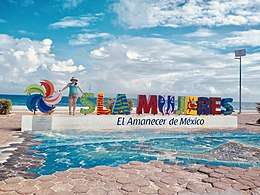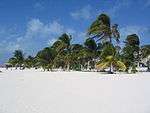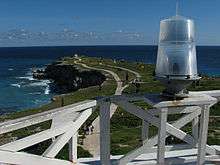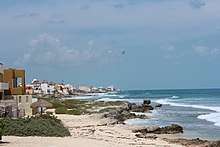Isla Mujeres
Isla Mujeres (Spanish pronunciation: ['izla mu'xeɾes], Spanish for "Island of Women” (formally “Isla de Mujeres”)) is an island where the Gulf of Mexico and the Caribbean Sea meet, about 13 kilometres (8.1 mi) off the Yucatán Peninsula coast. The island is approximately 7 kilometres (4.3 mi) long and 650 metres (2,130 ft) wide. To the east is the Caribbean Sea with a strong surf and rocky coast, and to the west the skyline of Cancún can be seen across the clear waters. In the 2010 census, the namesake town on the island had a population of 12,642 inhabitants.[1]
.jpg) Aerial view of southern portion of Isla Mujeres | |
| Geography | |
|---|---|
| Coordinates | 21°14′N 86°44′W |
| Adjacent bodies of water | Gulf of Mexico, Caribbean Sea |
| Length | 7 km (4.3 mi) |
| Width | 0.65 km (0.404 mi) |
| Administration | |
Mexico | |
| State | Quintana Roo |
| Municipality | Isla Mujeres |
| Demographics | |
| Population | 12,642 (2010) |
The island is part of the Isla Mujeres Municipality in the State of Quintana Roo, Mexico and includes an impoverished colonia on the mainland.
History
_-_Ancient_Shrine%2C_Island_Mugeres_-_Google_Art_Project.jpg)


In Pre-Columbian times the island was sacred to the Maya goddess of childbirth and medicine, Ixchel. When the Spanish arrived in the 16th century they named it "Isla Mujeres" because of the many images of goddesses. The first information available about Isla Mujeres is from the period between 564–1516 AD, when it was part of the Maya province called Ekab. There were 4 Maya provinces in what is today the State of Quintana Roo. The Maya also exploited the salt that the island produced in the "salinas" (small interior lagoons). The salt was used not only for the preservation of food and medicine but also as a generally accepted currency for commerce of goods along the whole Maya region. The Maya goddess Ixchel had a temple in what is today the Hacienda Mundaca (Mundaca's Plantation House). The island was also a favorite stopping place for pirates in the early 1800s. The shallow lagoon on the mainland side of the island was a good place for sailors to sit out major storms, careen their hulls and trade for salt. Pirates Henry Morgan, Jean Lafitte and Hernan Mundaca spent time there. Hernan Mundaca lived on the island for quite some time, building a large hacienda with which he hoped to entice a local beauty, Martiniana (Prisca) Gomez Pantoja, into marriage. She married someone else, to his regret. A small bit of his Hacienda is still there. It has served in the past as a zoo and as a place for young “novias” to find some privacy.
A small Maya temple was once located on the southern tip of the island. However, in 1988, Hurricane Gilbert caused extensive damage, leaving most of the foundation but only a very small portion of the temple.
Since the 1970s, along with nearby Cancún, there has been substantial tourist development in Isla Mujeres.
Transportation

Transportation on the island of Isla Mujeres consists primarily of taxis or golf carts and moped scooters. As of 2005 there were 121 taxis, 500 golf carts, and 1500 moped scooters.[2] There is also a bus service that runs from the downtown to the different neighborhoods, called colonias in Spanish (where most locals live). Unfortunately the island used to be served by Isla Mujeres National Airport but the airport and landing strip is no longer used for more than a place to get exercise, as many locals, military personnel, and/or tourist can be seen jogging up and down the runway at various times throughout the day.
Ferry service to the mainland
There are two main ferry boat companies (UltraMar and Marinsa) that run to the island from Puerto Juárez, Cancun, or Gran Puerto on the mainland. There are also party boats of all sorts that make day trips to Isla Mujeres. The island is popular with day trippers, but activity quiets down in the evening after the tour groups leave.
Tourism
.jpg)
.jpg)
There are numerous places to eat fresh seafood cooked with local and traditional recipes, and other restaurants offer Mexican, Yucatecan, Italian, Caribbean, Mediterranean, Israeli, French, Thai, Cuban, and Maya cuisine. Hotel prices vary from cheap to very expensive at the resorts on the southwest end such as Hotel Villa Rolandi, and Playa Norte. In the north is El Centro (downtown), whose central axis, Hidalgo Street, is the main dining and entertainment area. Also located on the north end is a famous beach called Playa Norte, which has recovered quickly since Hurricane Wilma hit the area in 2005. Besides these attractions, swimming with dolphins can also be experienced at the Island.
The island of Isla Mujeres is located close to one of many coral reefs such as the one located in Garrafon Park, which is an area popular for its snorkeling and scuba diving. The Cancún Underwater Museum, created by English sculptor Jason deCaires Taylor, is located off the western coast of Isla Mujeres.[3] Isla Mujeres is also home to a population of sea turtles. Because of the recent endangerment of sea turtles in the area, a facility named Tortugranja was set up on the southern end of the island for their rehabilitation and breeding. This facility is open to the public.[4]
The island's relative proximity to Cuba has made it one of the favorite stepping stones of Cubans trying to reach the United States in recent years.[5]
Isla Mujeres is considered to be one of the best places in the world to catch Sailfish.[6]

References
- "2010 census tables: INEGI" (PDF). Archived from the original (PDF) on 2015-11-14. Retrieved 2020-01-27.
- Census of 2005 Instituto Nacional de Estadística, Geografía e Informática, in Spanish.
- Vance, Erik (August 2013). "The Art of Distraction". Scientific American. 309 (2): 16. doi:10.1038/scientificamerican0813-16.
- "Making Memories on Isla Mujeres". Isla Mujeres Vacations. Retrieved 18 May 2015.
- Lacey, Marc (2007-10-15), "For Cubans, a Twisting New Route to the U.S.", New York Times, retrieved 2007-10-15
- Olander, Doug. "The World's Best Sailfish Spots". sportfishingmag.com. Sport Fishing Magazine. Retrieved 21 June 2019.
External links
| Wikimedia Commons has media related to Isla Mujeres. |

- Fideicomiso de Promoción Turística de Isla Mujeres Official tourism website
- Isla Mujeres at Curlie
